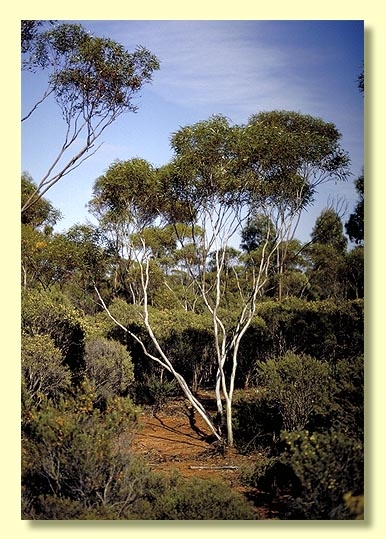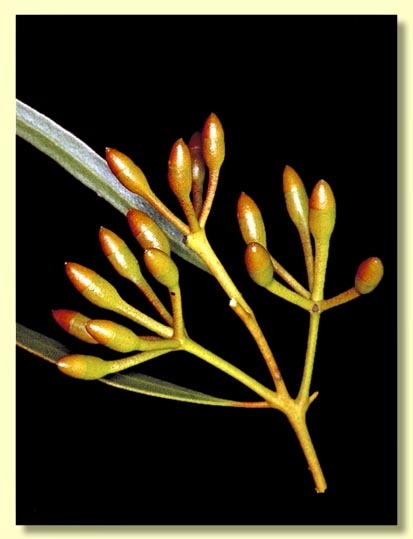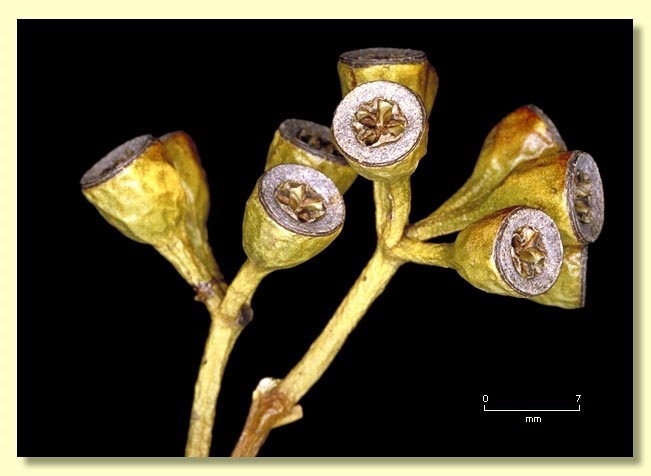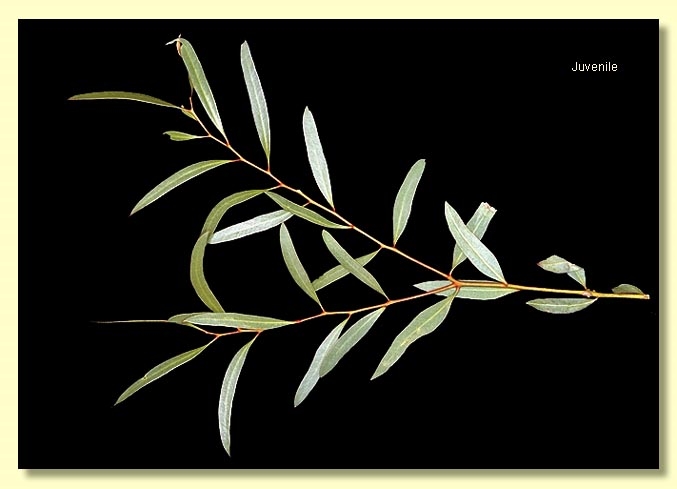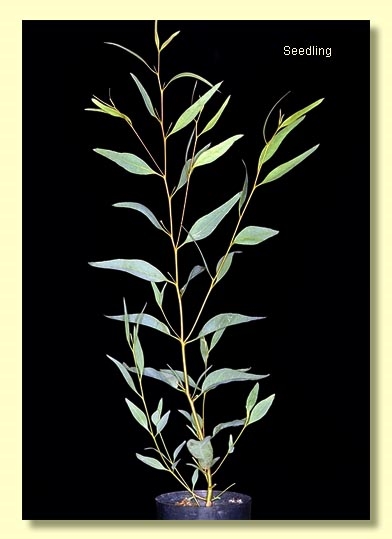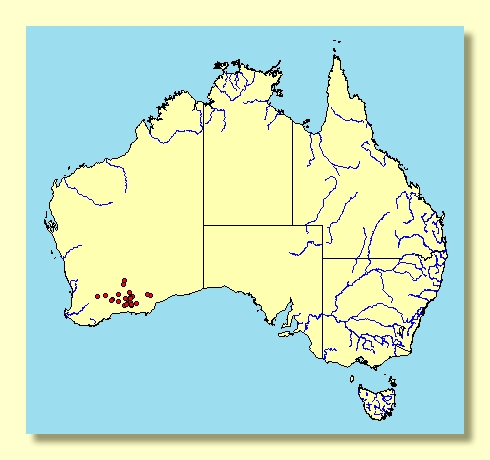Euclid - Online edition
Eucalyptus cylindriflora
Eucalyptus | Symphyomyrtus | Bisectae | Glandulosae | Elongatae
Bark smooth throughout, white to pale grey and yellowish grey.
Branchlets with oil glands in the pith.
Juvenile growth (coppice or field seedlings to 50 cm): stems rounded in cross-section; juvenile leaves always shortly petiolate, opposite for up to ca 15 cm of growth then alternate, lanceolate becoming linear up stem, 4–8 cm long, 0.5–1.5 cm wide, lower leaves dull, upper leaves glossy, green.
Adult leaves alternate, erect, petioles 0.3–1.3 cm long; blade linear, 4–7.5(9.5) cm long, 0.4–1(1.2) cm wide, base tapering to petiole, margin entire, apex pointed, concolorous, glossy, green, side-veins acute, reticulation sparse to obscure, intramarginal vein present, oil glands irregular, intersectional and island.
Inflorescence axillary unbranched, peduncles slender, 0.9–2.7 cm long, buds 7 per umbel, with long pedicels 0.4–1 cm. Mature buds ovoid to cylindrical (1–1.3 cm long, 0.4–0.7 cm wide), scar present (outer operculum lost early), inner operculum conical, outer stamens inflexed to varying degrees (rarely 1 or 2 fully erect), inner stamens strongly inflexed, anthers oblong, versatile, dorsifixed, dehiscing by longitudinal slits, style long and straight, stigma blunt to slightly dilated, locules 4(5), the placentae each with 6 or 8 vertical rows of ovules. Flowers creamy white.
Fruit pedicellate (pedicels 0.3–1.2 cm long), cylindrical to cupular, 0.6–1 cm long, 0.6–0.9 cm wide, disc usually descending obliquely, valves 4(5), small, about rim level.
Seeds brown, 0.5–1.5 mm long, flattened-ovoid, dorsal surface clearly reticulate, hilum ventral.
Cultivated seedlings (measured at node 10): cotyledons Y-shaped (bisected); stems rounded in cross-section; leaves always petiolate, opposite for 4 to 6 nodes then alternate, lanceolate, 5–9 cm long, 1.5–2.5 cm wide, dull, greenish.
Flowering has been recorded in January, February and March.
A small mallee endemic to Western Australia, from east of Bendering to Salmon Gums and almost to Balladonia but not coastal. The bark is smooth and the adult leaves narrow and glossy green.
Eucalyptus cylindriflora belongs in Eucalyptus subgenus Symphyomyrtus section Bisectae subsection Glandulosae because the buds have an operculum scar, cotyledons are bisected and branchlets have oil glands in the pith. Within this large subsection (ca 80 species) E. cylindriflora is closely related to a group of mallees or mallets (series Elongatae ) recognised by the glossy green leaf surface, leaves with many oil glands obscuring the reticulation but not the main side-veins, buds with very long conspicuous pedicels, short opercula, inflexed stamens and ovules in 6 or 8 vertical rows. There are five species in series Elongatae—E. cylindriflora, E. cerasiformis, E. dielsii, E. armillata and E. erythronema (with 2 subspecies) .
E. cylindriflora is distinguished in its natural range by its linear leaves, erect inflorescences, long-pedicellate cylindrical buds that are in erect (not pendulous) clusters of seven and more or less cylindrical fruit with an obliquely descending disc. Its closest relative is E. cerasiformis, which has pendulous clusters of smaller, more blunt buds that are narrowed in the middle. E. dielsii is a mallet with pendulous buds in sevens and a fruit with a "brim" like a small bowler hat. E. erythronema is a mallee with larger buds in threes (sometimes sevens also) and obconical fruit.

